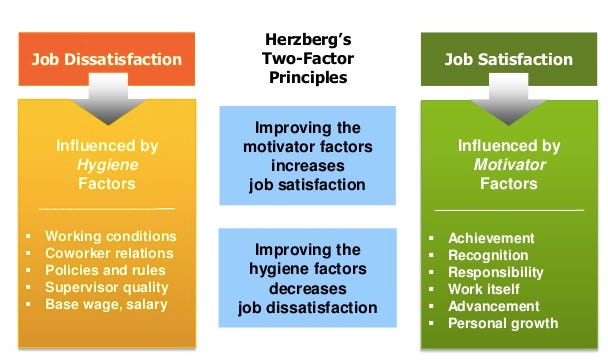Herzberg’s Two-Factor Theory
Bae you ever asked yourself: How can I motivate my employees? Before you can motivate the team, you need to resolve job dissatisfaction.
Key Takeaways
The things that cause job satisfaction and the things that lead to job dissatisfaction are not the same things.
Hygiene Factors consists of company policy, supervision, interpersonal relationships, working conditions, salary, status, and security.
Motivator Factors include recognition, the work itself, responsibility, and growth or achievement.

Frederick Irving Hertzberg was an American psychologist, who became one of the most influential names in business management. Hertzberg proposed The Motivation Hygiene Theory in 1959 in the book The Motivation to Work. The theory is also known as the two-factor theory of job satisfaction. The theory is based on an extensive survey of motivational factors at work. This theory is often used in the context of Maslow's Hierarchy of Needs.
Herzberg conducted a number of experiments with nearly 1700 workers from all walks of life. He asked them what job events had occurred in their work that led to extreme satisfaction or extreme dissatisfaction on their part. The shocking thing that Herzberg learned was that the things that cause job satisfaction and the things that lead to job dissatisfaction are not the same things. 1
He reached the conclusion that conditions in the workplace can be divided into two main groups of factors: hygiene factors (also called maintenance factors) and motivator factors.
Hygiene Factors
The things that lead to dissatisfaction he called hygiene factors. They include company policy, supervision, interpersonal relationships, working conditions, salary, status, and security. Hygiene factors cannot create motivation, but rather, they can only prevent and reduce dissatisfaction and negative attitudes.
Even if all the hygiene factors are not dissatisfying, that doesn't mean the employee experiences job satisfaction. It just means they aren't annoyed by the way the company does things.
For example, Herzberg theory would also say that if you take a job for the salary or benefits, you will eventually be unhappy in your work. That's because compensation is a hygiene factor. Here's why:
Do you remember what it felt like to get a raise? Pretty great, right? How long did that feeling last? Probably not until you got your next paycheck. But how long does the dissatisfaction lasti f you discover that someone else doing your job is paid a lot more money? It stays with you like having a pebble in your shoe.
Hygiene factors must first be met (there must be no dissatisfaction among the employees). Only then can you work on their motivation factors.
Motivator Factors
The things that lead to job satisfaction are motivator factors. They include achievement recognition, the work itself, responsibility, and growth or achievement. Although motivator factors create positive attitudes towards work, motivational factors should be important to the individual employee.
Adopting the Two-Factor Theory in the Workplace
At some point, you will wonder how do I motivate these people? It may be tempting to offer bonuses, high status in the organization, or a special parking spot. But Herzberg would predict that these carrots will only motivate your people as long as there are more and more and more carrots.
As a manager, you can use the model in respect of your employees by adopting a two-stage process to motivate people:
First, you need to eliminate any dissatisfaction that they're experiencing.
Second, you need to help them to achieve satisfaction. To get rid of factors that dissatisfy your employees, you need to fix poor and obstructive company policies.
Provide effective and supportive and non-intrusive supervision.
Create and support a culture of respect and dignity for all team members.
Ensure that wages are competitive when compared to similar industries and positions.
Build job status by providing meaningful work for all positions.
Provide job security. Not by inly telling them that you will not dismiss or layoff staff. But you must make an effort to keep your employees by retaining and redeploying them to other jobs.
You have to show that you take job security seriously.
All of these actions help you eliminate job dissatisfaction in your organization. And there's no point trying to motivate people until these issues are out of the way.
His theory predicts that the best way to motivate people is to match people to the jobs that call for their natural talents. The things they enjoy doing most. Don't assign a big picture thinker to a job requiring exacting detail. Find someone who loves the details.
https://www.aafp.org/pubs/fpm/issues/1999/1000/p26.html#:~:text=Frederick%20Herzberg%20theorized%20that%20employee,more%20productive%2C%20creative%20and%20committed.


